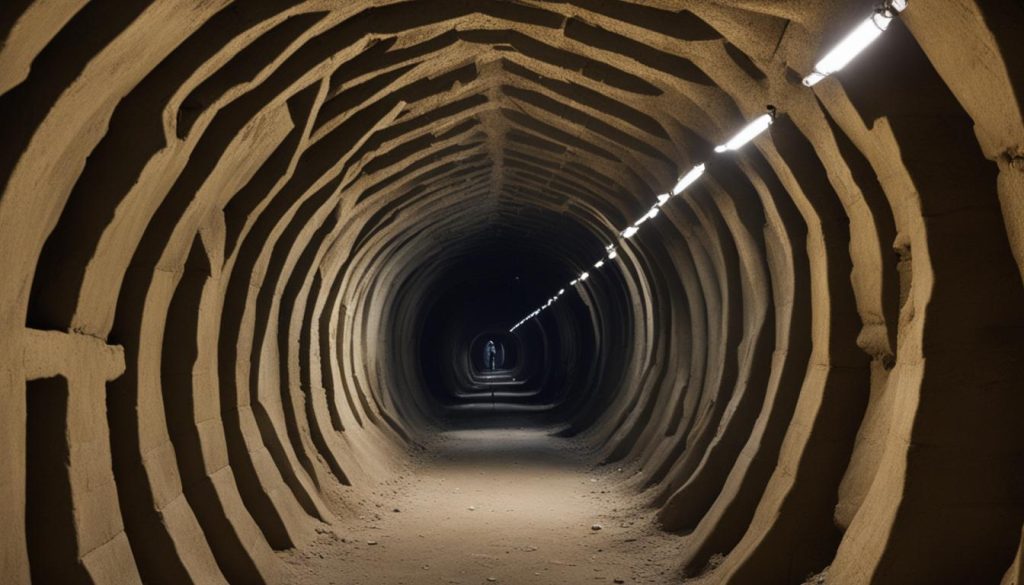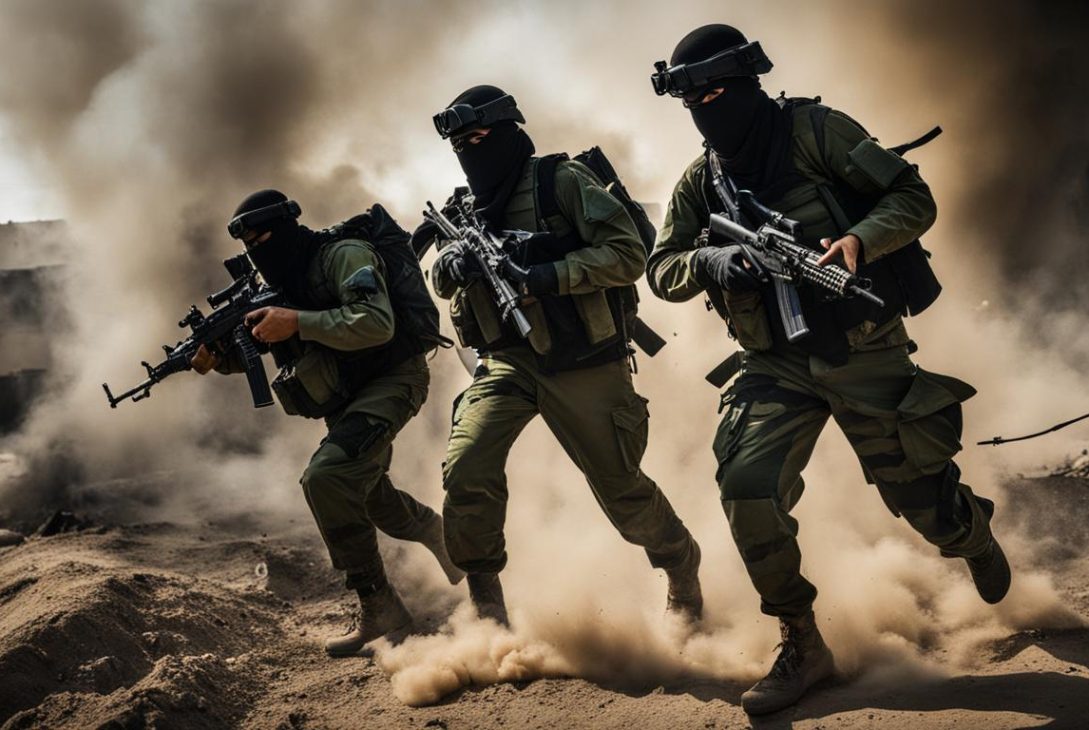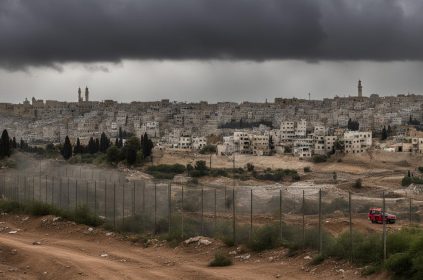The Israel-Hamas War, also known as the Israel-Gaza War, raises questions about the stability of the region. This conflict involves cyber threats, hacktivism, military operations, and broader geopolitical implications. The conflict began when Hamas fighters launched a surprise attack on Israel, leading to a declaration of war by Israeli Prime Minister Benjamin Netanyahu. The conflict has intensified with continued assaults and counter-assaults, with Hamas being linked to other militant and terrorist groups. The war has also played out on the digital front, with cyber threat actors using platforms like Telegram to rally support and conduct attacks.
Key Takeaways
- Hamas military operations have intensified the Israel-Palestine conflict.
- The conflict involves cyber threats and hacktivist activities.
- Hamas is linked to other militant and terrorist groups.
- Hamas utilizes digital platforms like Telegram for communication and attacks.
- The conflict raises questions about the stability of the region and has broader geopolitical implications.
The Roots of the Conflict: Israel-Palestine Tensions
The Israel-Hamas conflict is deeply rooted in the long-standing tensions between Israel and Palestine. The conflict traces back to the establishment of the modern state of Israel in 1948, which resulted in the displacement of many Palestinians, an event known as the Nakba.
The occupation of the Gaza Strip by Israel in 1967 and the Yom Kippur War in 1973 further escalated the conflict, fueling resentment and resistance among Palestinians. The Palestinian resistance movement Fatah emerged in 1959 as a response to the Nakba and played a significant role in the subsequent conflicts.
However, it was in 1987 that Hamas, another Palestinian resistance movement, came into prominence with widespread support. In 2006, after clashes with Fatah, Hamas gained control of the Gaza Strip, creating a power dynamic that has perpetuated the conflict between Israel and Hamas. The Gaza Strip, a small coastal enclave, has become a recurring flashpoint for clashes and hostilities between both parties.
The October 7 Surprise Attack
On October 7, Hamas launched a surprise attack on Israel, unleashing a massive barrage of rocket fire from the Gaza Strip and infiltrating the country through a network of tunnels. This audacious assault took both Israel and the international community by surprise, resulting in a declaration of war by Israeli Prime Minister Benjamin Netanyahu.
The attack marked a significant escalation in the conflict, resulting in hundreds of casualties and numerous hostages. Hamas was not acting alone, as other militant and terrorist groups such as the Izz al-Din al-Qassam Brigades, Palestinian Islamic Jihad, and Al-Aqsa Martyrs Brigade also participated in the assault. The coordinated nature of the attack demonstrated a high level of planning and coordination among these groups.
The use of tunnels by Hamas in the attack highlighted the group’s strategic capabilities and the effectiveness of their military operations. These tunnels allowed Hamas militants to infiltrate into Israel undetected, bypassing traditional border defenses. The tunnels also served as a means for transporting weapons, supplies, and personnel, enabling Hamas to conduct sustained attacks on Israeli targets. In response to the attack, the Israeli military launched a series of operations to identify and destroy these tunnels, aiming to prevent further infiltration and protect Israeli civilians.
| Hamas Attack on Israel | Rocket Fire from Gaza | Tunnels into Israel | Israeli Military Operations |
|---|---|---|---|
| Hamas launched a surprise attack on Israel, catching them off guard. | Hamas militants fired a massive barrage of rockets from the Gaza Strip. | Hamas utilized an extensive network of tunnels to infiltrate into Israel. | The Israeli military conducted operations to identify and destroy the tunnels. |
“The surprise attack by Hamas on October 7 showcased the group’s ability to carry out coordinated military operations, utilizing rocket fire from Gaza and a network of tunnels into Israel. The use of tunnels allowed Hamas militants to infiltrate undetected, posing a significant threat to Israeli security.” – Military Analyst
The Role of Cyber Threats in the Conflict
The Israel-Hamas War has witnessed the emergence of a digital battlefield. Cyber threat actors have joined the conflict, unleashing DDoS attacks and ransomware against Israeli and Hamas systems. Open source intelligence platforms like Telegram have become important communication channels for both militant groups and intelligence professionals. Hamas and its supporting groups have been using alternative versions of the Telegram app and VPNs to circumvent bans and censorship. The ban of Hamas and its militant wing on Telegram has led to the growth of new platforms like Rocket.Chat and Chirpwire. Additionally, hacktivist groups have aligned themselves either with Israel or Hamas, carrying out cyberattacks on institutions in both parties.
The use of cyber threats in the Israel-Hamas conflict highlights the increasing importance of cyber warfare in modern conflicts. Both sides have recognized the potential of leveraging technology and the internet to gain an advantage in the conflict. For Hamas, cyber attacks serve as a means to disrupt Israeli operations and spread propaganda. On the other hand, Israel seeks to neutralize Hamas’s cyber capabilities and defend its own critical systems. These cyber threats not only affect military operations but also have wider implications on civilian infrastructure and public perception.
To counter the cyber threats posed by Hamas, Israel has implemented various measures. These include strengthening cybersecurity defenses, conducting cyber operations against Hamas’s digital infrastructure, and sharing threat intelligence with international partners. Additionally, Israel has taken legal actions against individuals and organizations involved in cyber attacks. On the other hand, Hamas continues to adapt its cyber tactics to evade detection and maintain its digital presence. The conflict in cyberspace reflects the broader geopolitical struggle between Israel and Hamas, highlighting the importance of technological advancements in modern warfare.

The table below provides an overview of the major cyber threats and tactics employed by both Israel and Hamas in the conflict:
| Cyber Threat | Description |
|---|---|
| DDoS Attacks | Both Israel and Hamas have launched Distributed Denial of Service (DDoS) attacks against their respective targets to disrupt operations and gain a strategic advantage. |
| Ransomware | Hamas has utilized ransomware attacks to extort funds from Israeli organizations, while Israel has targeted Hamas’s financial networks with similar tactics. |
| Social Engineering | Both sides have employed social engineering techniques, such as phishing emails and social media manipulation, to gain unauthorized access to sensitive information. |
| Hacktivism | Various hacktivist groups have aligned themselves with either Israel or Hamas, carrying out cyber attacks and defacement of websites to support their respective causes. |
The use of cyber threats in the Israel-Hamas conflict demonstrates the evolving nature of warfare in the digital age. As technology continues to advance, the role of cyber warfare in conflicts is likely to increase. It is imperative for nations to develop robust cybersecurity capabilities and international cooperation to effectively counter such threats in the future.
Lessons Learned from Hamas’s Irregular Warfare Tactics
Hamas’s offensive against Israel has showcased the significance and effectiveness of irregular warfare tactics. Through their use of asymmetric, multidimensional, and indirect means, Hamas militants were able to carry out a surprise attack that overwhelmed the more powerful Israeli Defense Forces (IDF). This demonstrates the importance of adapting familiar tactics in new ways and highlights the impact of low-tech innovation in modern warfare.
One of the key lessons learned from Hamas’s irregular warfare tactics is the effectiveness of utilizing a combination of air, land, and sea forces. By employing these diverse means, Hamas was able to launch a multi-pronged attack that tested the capabilities of the IDF and demanded swift, coordinated responses from Israeli authorities. This highlights the need for militaries to be prepared for unconventional forms of warfare that go beyond traditional conflict scenarios.
Hamas’s offensive also underscores the importance of nonmilitary options in countering irregular warfare scenarios. The presence of civilians in the Gaza Strip and the use of human shields by Hamas militants created unique challenges for Israel’s military operations. Balancing the need to protect civilian lives with the objective of dismantling Hamas’s military capabilities posed significant difficulties for Israeli forces, and this aspect of the conflict must be carefully considered moving forward.
To effectively counter Hamas’s irregular warfare tactics, it is crucial for military strategists and policymakers to consider the lessons learned from this conflict. This includes developing strategies to mitigate the impact of surprise attacks, improving readiness for unconventional forms of warfare, and exploring nonmilitary solutions to address the root causes of the conflict. By doing so, future conflicts can be approached with a more comprehensive and nuanced understanding of the challenges posed by irregular warfare.
| Irregular Warfare Tactics | Impact |
|---|---|
| Use of asymmetric means | Overwhelmed the more powerful IDF |
| Multidimensional approach | Prompted swift, coordinated responses from Israeli authorities |
| Indirect means | Challenged traditional conflict scenarios |
The Significance of the Gaza Tunnel Network
The Gaza tunnel network controlled by Hamas plays a significant role in the ongoing conflict with Israel. Stretching over 300 miles, these tunnels are equipped with concrete reinforcement, electricity, and communication systems, enabling Hamas to carry out various activities. The significance of this tunnel network lies in its strategic placement near civilian sites, which allows Hamas to use human shields and fuel their propaganda strategy.
Hamas has been accused of locating control centers, storing weapons, training fighters, and even holding hostages inside these tunnels. By situating their operations near hospitals, schools, and mosques, Hamas makes it challenging for Israeli forces to target the tunnels without causing collateral damage to civilian infrastructure and risking civilian casualties. The group exploits the damage to civilian sites to further their propaganda, portraying Israel as intentionally targeting innocent civilians.
Hamas’s use of the Gaza tunnel network is an integral part of their broader strategy, one that relies on the presence of civilians as a shield against Israeli military action. This tactic creates a dilemma for Israel, as they strive to dismantle the tunnels while minimizing harm to civilian lives and infrastructure.
Efforts to counter Hamas’s tunnel tactics have proven to be challenging for Israel and Egypt. Operation Protective Edge in 2014 successfully demolished over 30 tunnels, but Hamas has since rebuilt and expanded the network. The difficulty lies in the placement of the tunnels, often hidden beneath civilian sites that are protected under international humanitarian law. Targeting the tunnels directly would result in the destruction of these civilian structures and risk civilian casualties, playing into Hamas’s strategy of using human shields.
| Gaza Tunnel Network | Impact |
|---|---|
| Strategic Placement | Allows Hamas to use human shields and fuel propaganda strategies |
| Military Operations | Used for storing weapons, housing control centers, training fighters, and holding hostages |
| Challenges for Countermeasures | Difficult to target without causing collateral damage to civilian infrastructure and risking civilian casualties |
The presence of the Gaza tunnel network creates complex challenges for Israel’s military operations. Balancing the need to protect civilian lives with the requirement to dismantle these tunnels remains a significant obstacle. As the conflict continues, finding effective solutions to address Hamas’s tunnel tactics while minimizing harm to civilians and infrastructure remains a critical priority.
The Challenges of Countering Hamas’s Tunnel Tactics
Israeli efforts to destroy Hamas’s tunnel system have posed significant challenges in the Israel-Hamas conflict. While Israel has conducted operations to demolish tunnels, Hamas has proved resilient in rebuilding and expanding its network.
One of the main challenges in targeting the tunnels lies in their strategic placement. Hamas often locates the tunnels under civilian sites such as hospitals, schools, and mosques. These civilian structures serve as human shields, complicating Israel’s operations. Directly targeting the tunnels could result in the destruction of vital civilian infrastructure and risk civilian casualties, playing into Hamas’s strategy of using civilians to their advantage.
This difficulty in targeting the tunnels creates a dilemma for Israel. On one hand, they must neutralize the threat of Hamas’s military operations and protect their citizens. On the other hand, they must avoid causing harm to innocent civilians and risking international condemnation. The presence of the tunnel network makes it challenging for Israel to effectively combat Hamas’s military activities without inflicting significant collateral damage.
Moreover, Hamas’s use of civilian sites to shield their tunnel network further complicates the situation. It fuels a propaganda strategy in which any damage caused to these sites is exploited to generate international sympathy and condemnation of Israeli forces. The international community’s perception of the conflict is influenced by the presence of civilians in the area and the resulting civilian casualties.

Table: Comparison of Israeli Efforts and Challenges in Targeting Hamas’s Tunnels
| Efforts | Challenges |
|---|---|
| Operation Protective Edge in 2014 | Demolition of over 30 tunnels |
| Strategic placement of tunnels under civilian sites | Risk of destroying civilian infrastructure |
| International condemnation for civilian casualties | Exploitation of damage to civilian sites for propaganda |
| Egyptian efforts to destroy the tunnel system | Hamas’s resilience in rebuilding and expanding the network |
The comparison table above highlights the efforts made by Israel in targeting Hamas’s tunnels and the challenges they face. Operation Protective Edge in 2014 was successful in demolishing a significant number of tunnels, but the strategic placement of these tunnels under civilian sites creates a dilemma for targeting, as it risks civilian casualties and infrastructure damage. Additionally, Israel faces international condemnation for civilian casualties and is confronted with Hamas’s exploitation of damage to civilian sites for propaganda purposes.
The Role of Tunnels in Hamas’s Human Shield Strategy
Hamas, the Palestinian militant group, has strategically utilized tunnels near civilian sites as part of its human shield strategy in the Israel-Hamas conflict. These tunnels have been accused of housing control centers, storing weapons, and conducting military operations under hospitals, schools, and mosques, making it challenging for Israeli forces to target them without causing collateral damage to civilian infrastructure and risking civilian casualties. This tactic has further complicated the situation on the ground and posed significant challenges for Israel’s military operations.

The presence of tunnels near civilian sites allows Hamas to exploit the damage to these sites for propaganda purposes, fueling international condemnation of Israeli actions. By utilizing innocent civilians as human shields, Hamas seeks to create a narrative of Israeli aggression and highlight the perceived disregard for civilian lives. This propaganda strategy aims to garner sympathy and support for the Palestinian cause, while also placing Israel in a difficult position when conducting military operations.
Israel faces a complex dilemma in countering Hamas’s tunnel tactics. The presence of the tunnel network, strategically located in densely populated areas, makes it difficult for Israeli forces to effectively combat Hamas without causing significant damage to civilian sites. This challenges Israel’s military operations and international perception, as any action taken to neutralize the tunnels may result in civilian casualties and further fuel Hamas’s narrative. Thus, finding a solution that minimizes harm to civilians and addresses the threat posed by the tunnel network remains a significant challenge in the Israel-Hamas conflict.
The Role of Tunnels in Hamas’s Human Shield Strategy
| Hamas Tactics | Impact |
|---|---|
| Locating tunnels under civilian sites | Makes it challenging for Israeli forces to target tunnels without causing collateral damage to civilian infrastructure |
| Exploiting damage to civilian sites for propaganda | Reinforces Hamas’s narrative of Israeli aggression and generates international condemnation |
| Using innocent civilians as human shields | Complicates Israel’s military operations and places the country in a difficult position |
In summary, Hamas’s use of tunnels near civilian sites is a crucial element of its human shield strategy in the Israel-Hamas conflict. By locating control centers, storing weapons, and conducting military operations under hospitals, schools, and mosques, Hamas makes it difficult for Israeli forces to target the tunnels without causing collateral damage to civilian infrastructure and risking civilian casualties. This strategy allows Hamas to exploit the damage to civilian sites for propaganda, fueling international condemnation of Israeli actions. Israel faces a complex challenge in countering these tactics while minimizing harm to innocent civilians and effectively addressing the threat posed by the tunnel network.
Conclusion
The Israel-Hamas conflict, with its complex dynamics involving military operations, cyber threats, and geopolitical implications, underscores the deeply rooted tensions between Israel and Palestine. Hamas’s use of irregular warfare tactics, including surprise attacks and the extensive tunnel network, has posed significant challenges for Israel’s military operations. The presence of civilians in the conflict zone and the use of human shields by Hamas further complicates the situation.
This protracted conflict serves as a sobering reminder of the ongoing Israeli-Palestinian tension, which remains one of the world’s most enduring disputes. The Israel-Hamas war highlights the need for nonmilitary options to address irregular warfare scenarios and find a sustainable resolution. It also underscores the importance of international efforts to mitigate civilian casualties and damage to civilian infrastructure when targeting military assets.
To achieve lasting peace in the region, it is crucial to address the root causes of conflict, foster dialogue, and work towards a just and equitable solution that respects the rights and aspirations of both Palestinians and Israelis. While the road to peace may be long and challenging, it is essential to continue striving for a peaceful coexistence in the region for the well-being and prosperity of all its inhabitants.
FAQ
What is the root cause of the conflict between Israel and Hamas?
The conflict between Israel and Hamas is deeply rooted in the long-standing tensions between Israel and Palestine, including events such as the Nakba and the Yom Kippur War.
When did the conflict between Israel and Hamas begin?
The conflict escalated when Hamas launched a surprise attack on Israel on October 7.
How has the conflict played out in the digital realm?
The conflict has witnessed the emergence of cyber threats, with threat actors using platforms like Telegram to conduct attacks.
What tactics did Hamas use in their offensive against Israel?
Hamas used a combination of air, land, and sea forces in their offensive, overwhelming the more powerful Israeli Defense Forces.
What challenges does Israel face in countering Hamas’s tunnel network?
Israel faces challenges in targeting the tunnels directly due to their strategic placement near civilian sites, risking collateral damage and civilian casualties.
What is Hamas’s strategy regarding civilian sites and human shields?
Hamas has been accused of locating control centers and storing weapons under civilian sites, using human shields to complicate Israeli military operations.
Have there been any attempts to destroy Hamas’s tunnel network?
Both Israel and Egypt have made efforts to destroy the tunnel system, but the challenges lie in their locations under civilian infrastructure.
What is the significance of the Gaza tunnel network?
The tunnel network is a significant factor in the conflict, used by Hamas for various purposes and making it challenging for Israel to combat their operations effectively.
What is the overall impact of the Israel-Hamas conflict?
The conflict involves complex dynamics, including military operations, cyber threats, and geopolitical implications, and serves as a reminder of the ongoing Israeli-Palestinian tension.
Source Links
- https://www.wilsoncenter.org/blog-post/hamas-and-gazan-tunnels
- https://flashpoint.io/blog/israel-hamas-war-intelligence/
- https://foreignpolicy.com/2023/11/06/hamas-israel-gaza-war-irregular-warfare-idf-strategy/
conflict between israel and hamas Exploring the Intricacies of Hamas Military Operations gaza strip conflict hamas aggression israeli military operation isreal hamas war
Last modified: January 17, 2024









